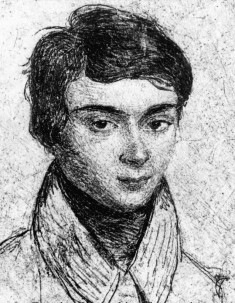Évariste Galois was a French mathematician. Despite his short life, he produced highly significant work, such as laying the foundations for what became known as group theory. He also worked in abstract algebra and solved a long-standing problem relating to polynomials. Galois was known for his republican sympathies, despite the fact that he lived during the reign of Louis Philippe. He died in a duel in which he received fatal wounds under circumstances that remain debatable.
Early Years
Galois was born near Paris on October 25, 1811, to parents who were well educated but not mathematically inclined. He was educated by his mother until the age of 12, when he was sent to Paris to continue his studies. A minor riot took place at about the time of Galois’s arrival, but he was not involved and survived the expulsion of dozens of his peers.
He proved particularly adept at Latin, but soon lost interest in it, his attention being caught only by mathematics from about 1825 onward. By the time he was 15, he was able to study the original works of Lagrange, as well as reading papers intended for working, professional mathematicians.
Despite his interest, Galois was not good at taking exams, and he failed the entry test for the prestigious École Polytechnique in Paris in 1828. Instead, he enrolled in the less renowned school of mathematics, the École Normale. He got on well with his professors, and his knowledge and ability increased rapidly. By the spring of 1829, he was able to publish his first paper, which dealt with continued fractions.
Slightly later that year, he submitted two papers on polynomial equation theory to the Academy of Sciences. The papers were evaluated by a high-ranking mathematician but were rejected; the reasons for this remain unclear.
Taking a Different Path
In July 1829, Galois’s father killed himself after a scandal in which his name had been forged by a local priest to make it look as though he were a libeler. The shame was overpowering and suicide seemed the only way out. The young Galois was devastated, and a further attempt to gain entry to the Polytechnique was also a failure.
One version of events suggests that he was simply making too many leaps of logic for his examiner to comprehend, although personal grief is the most widely accepted explanation. Galois stayed at the Normale and obtained his degree in late December of 1829. He was said to possess a “remarkable spirit of research” by one examiner, although another was deeply unimpressed and stated that he had “little intelligence.”
Galois’ Papers and Contributions
 While reading papers by Abel, Galois discovered that one overlapped his own work. In early 1830, a paper on the use of radicals to solve polynomials was passed to the Fourier of the Academy in Paris. The paper was considered sufficiently impressive to be in contention for the Grand Prize in Mathematics, but after Fourier’s death in April, the paper was mislaid.
While reading papers by Abel, Galois discovered that one overlapped his own work. In early 1830, a paper on the use of radicals to solve polynomials was passed to the Fourier of the Academy in Paris. The paper was considered sufficiently impressive to be in contention for the Grand Prize in Mathematics, but after Fourier’s death in April, the paper was mislaid.
Galois, swallowing his disappointment, produced three further papers before the year was out. One of these set down the basis of what would become the Galois Theory, which links field and group theory in abstract algebra. Another of the papers pioneered the concept of a finite field in number theory.
Galois’ Political Stances
In 1830, France suffered from a great deal of political unrest and instability. In July of that year, the director of the Normale went so far as to lock his students inside the building in order to stop them from joining in a nearby demonstration. Galois was highly critical of this decision in a letter, and this led to his dismissal from the Normale in early January of 1831.
He was unrepentant, and became a strong supporter of organizations such as the National Guard which championed the cause of republicanism. Galois continued to work on mathematical problems, but he was becoming more and more committed to the republican cause, to the extent of being arrested for wearing the uniform of the Republican Artillery.
Death and Legacy
The background to Galois’s death in a duel on May 31, 1832, remains unclear to this day. Some historians believe that the cause of the duel may have been related to a woman named Mademoiselle Poterin du Motel, to whom Galois became close. An alternative theory is that the man Galois fought was a member of the squad who had come to arrest him – and who was also the fiancé of du Motel.
Even the identity of his opponent is disputed, with other authorities suggesting that it was a friend from the republican movement. On May 29, Galois sent a letter to Chevalier with some mathematical notes attached. The following day, he was shot in the abdomen during the duel and died in a hospital in the early hours of the following morning at the age of just 20.
